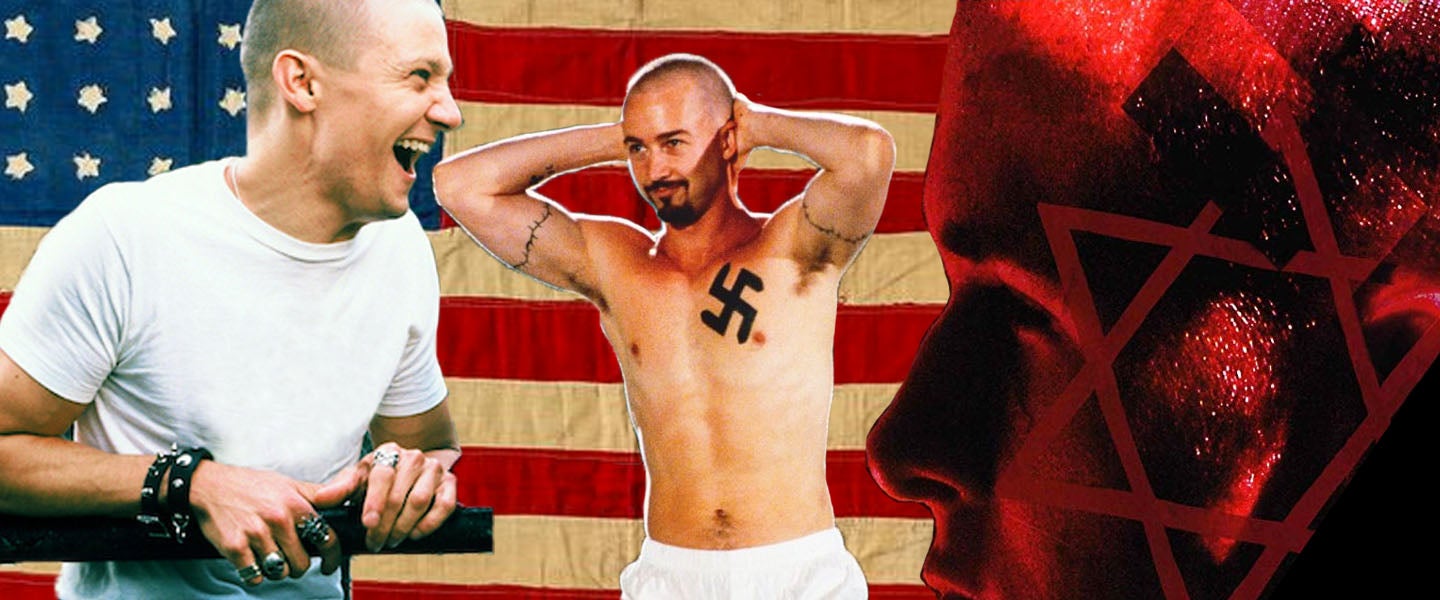Have you ever heard of a movie called Neo Ned? It stars a young Jeremy Renner as a dimwitted skinhead, committed to a mental institution after years of juvenile delinquency and racist violence. In the hospital he meets Rachael, played by Gabrielle Union. She’s a bright young woman suffering from a dangerous delusion: She thinks she’s the reincarnation of Adolf Hitler. The two kooky kids fall in love and hit the road, relishing the freedom to be exactly who they want to be, for as long as the law will allow.
This is a real motion picture, I swear.
It premiered at the Tribeca Film Festival in 2005. It won the audience awards at the Slamdance, Sarasota and San Diego Film Festivals… and those are just the fests that begin with the letter “S.” Click this link: That’s a New York Times article about Neo Ned. YouTube is full of clips and tribute videos — some of which have been posted by ardent Renner stans, and some by people stunned that this movie isn’t a joke.
Here’s the most popular scene on YouTube, which has been viewed over 140,000 times:
For those of you who haven’t seen Neo Ned (or didn’t know it existed until just now), it may surprise you to learn that it’s actually pretty good. Renner and Union give credible, lived-in performances; and director Van Fischer and screenwriter Tim Boughn have something powerful and personal to say about how bigotry is learned behavior, and can thus perhaps be unlearned. The movie presents Renner’s Ned as a lost child, raised in the alternate reality of militias and gangs.
But what may be most surprising about Neo Ned is its release date. Wasn’t 2005 a little late to be making an indie drama about neo-Nazis? Or — given what’s happened around the world over the past couple of years — was it maybe a little early?
There seems to be a cyclical nature to movies about white supremacist subcultures — and the men who populated them. The original heyday for cinema about skinheads happened in the early to mid-’80s, in the U.K., when England was overrun with the anti-immigrant National Front.
It was practically a rite of passage back then for promising young British actors to play scarily violent bigots. Tim Roth had his big career break in 1982, playing a racist ruffian in Alan Clarke’s TV movie Made in Britain. Gary Oldman (and Tim Roth again!) shaved their heads for Mike Leigh’s 1984 social drama Meantime. Daniel Day Lewis played an ex-separatist in love with a Pakistani entrepreneur in Stephen Frears’ 1985 arthouse hit My Beautiful Laundrette.
In the U.S., meanwhile, our exposure to racist cults in the mass media was largely limited to trashy daytime talk shows, foreign imports, and movies about the civil rights movement. Neo-Nazis popped up in popular culture rarely: in the occasional TV police procedural, for example; and, improbably, in the classic Seinfeld episode “The Limo,” where the gang gets mistaken for notorious white supremacists.
In retrospect, that Seinfeld episode proved prescient. It originally aired in February of 1992, which would become the year where America became more fully aware of the separatist subcultures growing in its midst. In August of ’92, multiple branches of federal law enforcement engaged in an extended violent standoff with an alleged anti-government band in Idaho — infuriating far-right talk-radio hosts, who started warning listeners about the dangers of FBI and ATF “jack-booted thugs.” For the rest of the decade, the news was regularly filled with stories about armed militias, domestic terrorists, and cult leaders: David Koresh, Eric Rudolph, Timothy McVeigh, Ted Kaczynski and others.
Slowly, pop culture caught on. Some American audiences first got to know actor Russell Crowe via writer-director Geoffrey Wright’s acclaimed 1992 debut feature Romper Stomper, in which Crowe played the charismatic, idealistic leader of an Australian skinhead gang. In 1995’s Higher Learning, writer-director John Singleton made the rise in Aryan organizations a key subplot in his college melodrama, casting Michael Rapaport as a confused, lonely student who gets coerced into joining a hate group by a friendly young neo-Nazi, played by Cole Hauser. In 1998, director Bryan Singer helmed an adaptation of the Stephen King novella Apt Pupil, about a soulless, sadistic high schooler who becomes obsessed with his neighbor, a former Nazi SS officer hiding in California.
None of these movies was meant to glamorize race-baiting or fascism. Still, some impressionable viewers fixated on the parts of the films where the Nazi sympathizers made their cases against immigrants and people of color, and ignored the parts where the racists destroyed lives. Romper Stomper in particular has been cited as a factor in multiple instances of racist violence, including Dylann Roof’s church shooting in Charleston.
The same thing happened with 1998’s American History X, even though the actual plot of the film — in which a neo-Nazi ex-con played by Edward Norton tries to keep his younger brother from following in his footsteps — expressly argues that racism is corrosive and blinkered. To create a believable reality for these characters, the writers, directors and actors in these movies invest a lot in the scenes where the skinheads plead for the superiority of the white race.
Then there’s The Believer, writer-director Henry Bean’s Sundance Film Festival Grand Jury Prize–winning drama, featuring a 20-year-old Ryan Gosling in one of his first big movie roles, based loosely on the true story of a Jewish-American who joined the Ku Klux Klan. It’s a thrilling performance from Gosling, playing a brilliant young man who’s spent his whole life questioning everything he’s been told, to the point where he inevitably begins to doubt the ideas and beliefs his own people hold sacred.
The Believer is in some ways the apotheosis of the wave of neo-Nazi-themed movies that were released during what could be called the “militia paranoia” age. The film cuts to the heart of why seemingly intelligent young men become alienated and angry, and how they can choose to channel those feelings into something destructive.
It also marked the end of an era of sorts, because of when it debuted: in early 2001, about eight months before the terrorist attacks of 9/11. By the time The Believer was actually released in theaters in May 2002, the American moviegoing public was jittery and panicked about something other than homegrown antisemitism and white supremacist movements.
Which brings us back to Neo Ned, which also had a long run on the regional festival circuit and then sat on a shelf, before getting a belatedly wider release on cable and DVD in 2008, more than three years after its Tribeca premiere. Though it’s solidly made and well-acted, in the George W. Bush years the movie just didn’t seem… relevant.
Perhaps we should’ve paid more attention.
In November of last year, the New York Times Magazine published a lengthy and incisive Janet Reitman report on how the major federal law enforcement agencies and the Department of Homeland Security paid less attention to nationalism in the 2000s and 2010s — at first because they were occupied with stopping foreign-born terrorists, and then because in the Obama years the people in charge were worried that focusing on racial and religious intolerance would draw the Republicans’ ire.
Then, in 2017, came the Charlottesville riots, and ever since nearly anyone with a badge has been scrambling to catch up on just what’s been happening for the past 20 years. In some of the most revealing passages of Reitman’s article, she talks to some of the men who marched in Charlottesville, and finds that many were generally rootless and anti-authoritarian throughout their teen and young adult years, drifting toward the radical right after first dabbling in leftist progressivism and libertarianism.
In other words: They’re a lot like Ryan Gosling’s character in The Believer, who yearns to be “free thinker”; and they’re a little like Jeremy Renner’s character in Neo Ned, who’s so desperate to belong somewhere that he clings to the promise of a coming race war, which he’s been told will divide America into four peacefully coexisting quadrants. (Meanwhile, Ned admits to his would-be girlfriend, the reincarnated Hitler, that he hasn’t read Mein Kampf… perhaps because studying up on the things he claims to believe would spoil the fantasy.)
Is it time for a renaissance of movies like American History X and Neo Ned? One of this year’s Best Picture nominees is BlackKklansman, which pointedly ties a police investigation into Klan activity in the ’70s to what’s going on right now. And at this year’s Sundance, one of the most popular films was Blinded by the Light, a mostly upbeat story about a British Pakistani teen who becomes obsessed with the music of Bruce Springsteen circa 1987, which helps him endure the taunts and bullying of the local National Front gangs.
There’s a moment in Blinded by the Light when an older white neighbor knocks on the hero’s door, and tells him that he fought to rid the world of Nazis in World War II, and now can’t believe they’re marching in the streets of their hometown of Luton. It’s a line aimed not at the England of 1987, but 2019.
Remember that old saying about how those who don’t study history are doomed to repeat it? Perhaps the same is true of movies. If we don’t watch — really watch — the likes of Made in Britain and Romper Stomper and Neo Ned, we’ll be damned to keep getting new waves of these films, roughly every decade, until the end of everything.

